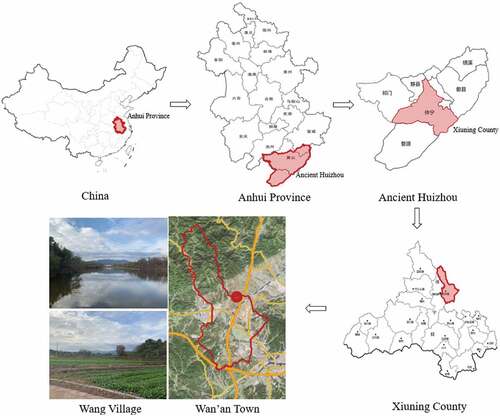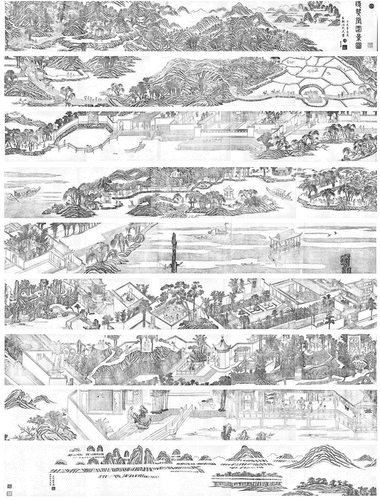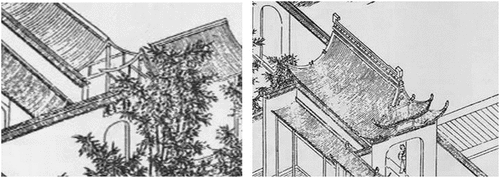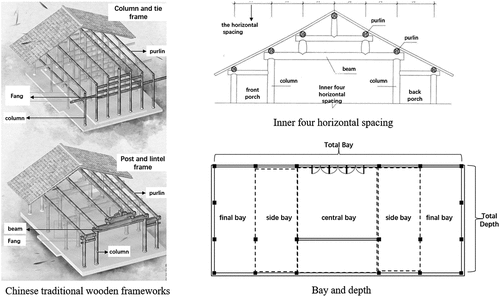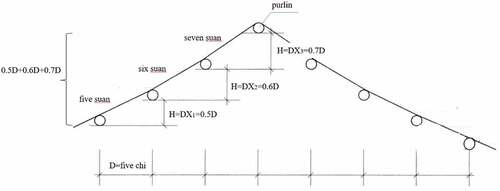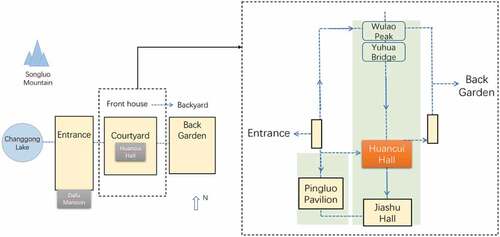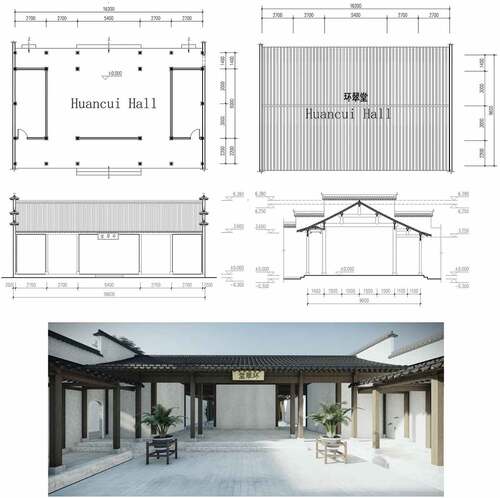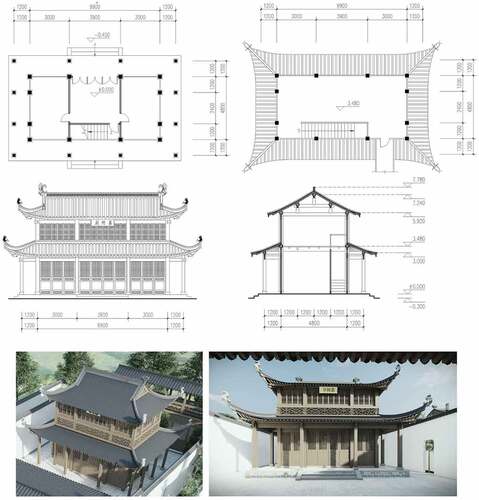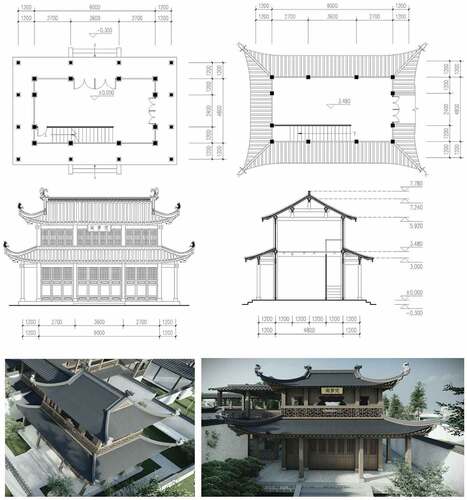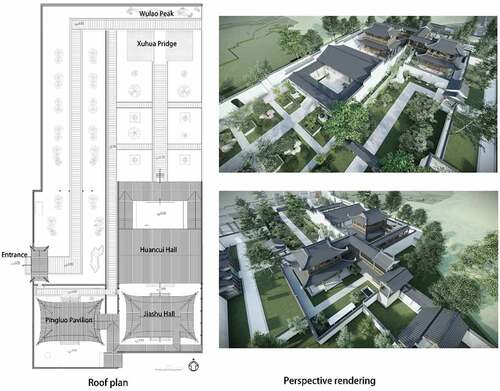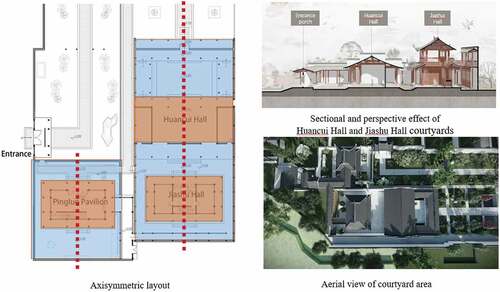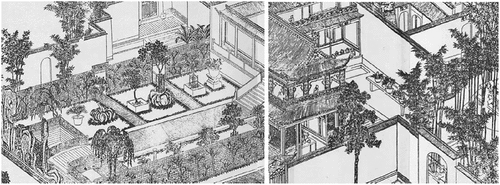Abstract
Huizhou garden is a branch of the gardening system in the regions south of the Yangtze River in China, which has not been studied by many researchers because there are few relics. Located in Xiuning County, Huangshan City, Anhui Province, Zuoyin Garden is a garden of the Ming Dynasty, which was built by Wang tingne, a Huizhou merchant, during the Wanli period. There is only a water source at the current base, as the ground buildings were destroyed. Wang Tingne published a long scroll print of Huizhou, the Garden View of Huancui Hall to depict the complete landscape. The purpose of this paper is to bring academic attention to the heritage of Huizhou gardens through the restoration of Zuoyin Garden.It is also expected that the restoration results will become the design basis and reference for relevant construction units to reconstruct Zuoyin Garden, and can also provide inspiration for the conservation and research of local gardens. In this paper, the main buildings that are depicted most clearly in the print were studied.The scientific structure determination, dimension speculation and courtyard layout were carried out according to the method of graphics and text derivation and the ancient technical architectural laws based on the gardening background, and several perspective renderings were modeled. Through the restoration study, it is found that the Zuoyin Garden has the characteristics of superior site selection, regular layout, elegant courtyard and gorgeous architectural decoration, and the natural landscape environment and humanistic environment of Huizhou has nurtured the unique Huizhou garden culture, which indicates that Huizhou garden is also an excellent garden cultural heritage and expands the research content of garden in the regions south of the Yangtze River in China.
JEL Classification:
1. Introduction
Zuoyin Garden is a “disappeared garden”, which was built during the Wanli period (1573 ~ 1620) of the Ming Dynasty in China. It is located in Wang Village, Wan’an Town, Xiuning County, Huangshan City, Anhui Province. There is only a water source at the current base, as the ground buildings were destroyed during the days of the Taiping Heavenly Kingdom (Figure ). Wang Tingne, the owner of the garden, who called himself “Mr. Zuoyin”, was a dramatist and publisher in the Ming Dynasty. He opened the bookshop Huancui Hall to publish engraved books (Xiuning Local Chronicles Compilation Committee, Citation1990). There is an anthology of poems and proses in his self-compiled collected works, the Complete Works of Mr. Zuoyin, including the Notes of Huancui Hall of Mr. Zuoyin and the Inscription of the Completion of Zuoyin Garden (Tingne, Citation1997). In addition, Wang Tingne’s Huancui Hall Bookshop published a long scroll print of Huizhou, the Garden View of Huancui Hall (Tingne, Citation2014) (Figure ). It is a valuable material to study Huizhou gardens and buildings in the Ming Dynasty.
Zuoyin Garden is located in Xiuning County in the south of Anhui Province, China. It belonged to ancient Huizhou in history. The geographical scope of Huizhou mainly includes She County, Xiuning County, Jixi County, Yi County, Qimen County in Anhui Province and Wuyuan County in Jiangxi Province. Huizhou, in ancient times, belonged to the three Miao tribes. Before the Wei Jin Dynasties, it was considered a “paradise” to escape from the war because of the dangerous terrain, which made it easy to defend and difficult to attack. Large families from the north migrated here to live by the mountains and water, gradually forming villages. After the Southern Song Dynasty, people went out of their villages and did business outside, forming the Huizhou merchants. After gaining capital, Huizhou merchants returned to their hometowns to purchase land and properties and repair ancestral halls and genealogies. Huizhou merchants emphasized farming and reading, and formed the backbone of Huizhou culture. These provided the economic and cultural foundation for the development of Huizhou gardens. Ancient Huizhou has a hilly terrain with wonderful and magnificent mountains and waters, including Huangshan Mountain, Qiyun Mountain, Xin’an River, and Taiping Lake. The superior natural mountains and waters have bred a large number of ancient villages in Huizhou, such as Xidi Village, Hongcun Village and other world cultural heritages.
In recent years, many researchers have studied Zuoyin Garden according to the print. For example, Professor Xu Hao (Citation2018) analyzed the spatial environment and construction characteristics of Zuoyin Garden, and drew a planar intention chart (Hao, Citation2018). Professor Wang Xin (2017) studied and summarized the sixteen views of the Garden View of Huancui Hall from the perspective of ancient rural garden (Qunho & Xin, Citation2017). Wang Ran (Citation2017) determined the direction, position and spatial structure of Zuoyin Garden and its environment based on literature, historical materials and field investigation, and comprehensively and reasonably re-stored the overall layout of Zuoyin Garden (Ran, Citation2017), which is a detailed interpretation of the Garden View of Huancui Hall from the perspective of garden. The insight to the previous studies of the site focused on the layout of garden,which reveals the lack of studies regarding analysis or design proposals for the main building.
The research object of this paper is the main building in Zuoyin Garden, including Huancui Hall, Jiashu Hall, Pingluo Pavilion and the courtyard space between them. This part is the core area in the Zuoyin Garden, reflecting the characteristics of the Huizhou garden and life quality of the Huizhou merchant family in the Ming Dynasty.The print Garden View of Huancui Hall is the most direct image reference for the restoration design in this paper, and the Notes of Huancui Hall of Mr. Zuoyin included in the Complete Works of Mr. Zuoyin is an important supplement to the restoration design. It is expected to bring academic attention to the heritage of Huizhou gardens through the restoration of Zuoyin Garden. The restoration results will become the design reference for relevant construction units to reconstruct Zuoyin Garden.
2. Materials and methods
2.1. Materials
2.1.1. Garden View of Huancui Hall
The Garden View of Huancui Hall, a long scroll print of Huizhou with a length of 14.86 meters and a width of 0.24 meter was completed in the 17th century. The print was painted by Qian Gong, a painter in Suzhou, and engraved by Huang Yingzu, a engraver in Huizhou. The original is no longer known, but the first printing of Huancui Hall was treasured by Fu Xihua, a collector in China, and published in 1981. The print depicted the view of Zuoyin Garden with Huancui Hall as the core and it is the most detailed image record of Zuoyin Garden.
2.1.2. Notes of Huancui Hall of Mr. Zuoyin
The Notes of Huancui Hall of Mr. Zuoyin is included in The Complete Works of Mr. Zuoyin, written by Yuan Huang, a scholar of the Ming Dynasty. The text of Notes of Huancui Hall of Mr. Zuoyin is over 2660 words, which starts with the main hall, Huancui Hall.Orientation words are used to record the relative positions of the scenic spots.It is a strong evidence for layout and can clarify the difficult points in the overall layout.
2.1.3. Yuan ye
The Yuan ye was written by Ji Cheng, a gardener in the Ming Dynasty and was completed in 1631 (Cheng, Citation2009). It is the earliest monograph xfgon gardening in China, as it summarizes and elaborates on the rules and techniques of gardening systematically in Jiangnan. Zuoyin Garden is built in the Ming Dynasty, as it is similar to historical setting in gardening described in Yuan ye and can be used to guide the restoration of the garden.
2.1.4. Yingzao Fayuan
The Yingzao Fayuan written by Yao Chengzu in the Qing Dynasty is a monograph describing the construction methods of ancient buildings in the regions south of the Yangtze River in China (Hongde & Xiaoqi, Citation2013). Since there was no local architectural technical literature in ancient Huizhou for reference purposes, and Huizhou belongs to the regions south of the Yangtze River in both the region and the cultural ring, the determination of architectural structure form and some dimensions was based on the Yingzao Fayuan. Wang Tingne lived in Nanjing for several years and made acquaintances in Nanjing, Suzhou and other places. The garden culture in the regions south of the Yangtze River also affected the construction of Zuoyin Garden. From the “column and tie” beam frame structure exposed by building units in the print, it can be deduced that these buildings had wood structure in the regions south of the Yangtze River. The pattern of the engraved end ridge of the main ridge of the building and the warping degree of the diagonal ridge of the building also had a tone of the regions south of the Yangtze River. (Figure ). Therefore, the Yingzao Fayuan is the main basis to speculate on the architectural style of the main building in this paper.
3. Methods
3.1. Image observation method
Since there are no remains of building components left at the base and there is no record of the dimensions in literature, the layout plan of the buildings to be restored was judged and the architectural form was determined aided by the observation of the architectural image of the print. The courtyard area presents a stable parallel projection relationship in the long scroll print, which was conducive to the scientific calculation of dimensions. Other dimensions could be inferred according to a determined dimension in the same direction. For example, after determining the depth of a building, the depth of its courtyard could be inferred; in terms of vertical heights, the height of the cornice could be inferred according to the height of the character under the cornice in the picture, and so on.
3.2. Literature research method
There is an anthology of poems and proses, the Complete Works of Mr. Zuoyin, including the Notes of Huancui Hall of Mr. Zuoyin and the Inscription of the Completion of Zuoyin Garden written by Yuan Huang and Li Zhihao, scholars of the Ming Dynasty, and poems inscribed by writers Zhu Zhifan and Gu Qiyuan for the garden, which were also included in the Complete Works of Mr. Zuoyin. (Tingne, Citation1997) Through the analysis of the notes and poems of garden related to the Zuoyin Garden, the relevant garden and architectural information is extracted to support the conclusions drawn from the image observation.
3.3. Technical literature inference
The Yuan ye and Yingzao Fayuan are the technical support for restoration. The discussion on site selection, foundation establishment, layout and design methods in Yuan ye provides theoretical principles for the overall restoration of the Zuoyin garden. The summary of structure, shape and decoration of buildings in the south of the Yangtze River in Yingzao Fayuan provides a basis for the structural restoration of buildings such as Huancui Hall.
3.4. Case reference
Since the construction style of Zuoyin Garden was determined to be a style in the regions south of the Yangtze River, architectural cases of gardens in the regions south of the Yangtze River, such as Suzhou and Nanjing, could be used as reference in their style, layout and dimensions to verify and make comparison during the restoration of the main buildings of Zuoyin Garden.
3.5. Digital modeling
In order to better display the restoration results, AutoCAD software is used to draw the plan, elevation and section of the building, while Sketchup design software is used to build 3D model.Lumion as a rendering tool, is considered to display 3D-effect Drawing.
3.6. Introduction to terms of traditional architecture
This paper involves several proper nouns of practice of Chinese traditional architecture and architecture in the regions south of the Yangtze River, which are hereby specially interpreted and explained in order to provide a better understanding of this paper.
3.6.1. Post and lintel frame and column and tie frame
There are two major architectural forms of Chinese traditional wooden frameworks(Figure ): post and lintel frame and column and tie frame. The post and lintel frame denotes a beam that is set up on the column, another beam is placed on the lower one, and so on, with the beams connecting with the purlin. The column and tie frame denotes the purlin that is directly supported by the column with the columns directly connected by Fang.
3.6.2. Front windowed veranda, inner four horizontal spacing and back two horizontal spacing
In buildings in the regions south of the Yangtze River, the horizontal distance between adjacent purlins is called the horizontal spacing. The four horizontal spacings are connected together to form the inner four horizontal spacings. The width of the horizontal spacing is known as the spacing depth. A spacing connected in front of the inner four horizontal spacings is the front porch (which can also be in the form of “windowed veranda”). A spacing connected on the back is the back porch. They are collectively known as “inner four horizontal spacing, front and back porches” (Figure ). If two horizontal spacings are connected on the back of the inner four horizontal spacings with a cross beam, it is called the back two horizontal spacing (Hongde & Xiaoqi, Citation2013).
3.6.3. Bay and depth
The total depth of a building is the total width of the inner four horizontal spacings and the front and back porches, which can be understood as the total width of the building perpendicular to purlins. Bay refers to the distance between adjacent columns parallel to the direction of purlins. Traditional buildings are composed of several bays with different names according to their location. Taking the five-bay as an example, the bay in the center is called “central bay”, the two bays next to it are called “side bay”, and the outermost two are called “final bay” (Figure ). The sum of the spacing of all bays is the total bay or total width (Hongde & Xiaoqi, Citation2013).
3.6.4. Raising-of-truss
Raising-of-truss is the practice of roof slope of the buildings in the regions south of the Yangtze River. This method is called “Ju Jia” in the Qing Dynasty (Sicheng, Citation2006b), “Ju Zhe” in the Song Dynasty (Jie, Citation2006), and “Ti Zhan” in the Yingzao Fayuan. What is raising-of-truss? “The spacing depth of the house is equal. The height of two purlins increases from top to bottom. As a result, the roof slope is higher as it goes farther back. The creation of curved roof in Chinese architecture is based on this method, which is called raising-of-truss (Hongde & Xiaoqi, Citation2013). ” The raising height of purlin (H) is related to the spacing depth (D) it is located, which is equal to the spacing depth multiplied by the raising-of-truss coefficient. Let the coefficient be X and list the formula H=DX. The raising-of-truss coefficient of each spacing varies. Starting from the front porch, the initial raising-of-truss coefficient X1 is related to the spacing depth. If the spacing depth is four chi, the initial raising-of-truss coefficient is four “Suan”, i.e., 0.4. With the raising of a purlin, X2 and X3 increase to 0.5 and 0.6 respectively. For example, for a seven-spacing hall with “front windowed veranda, inner four horizontal spacing and back two horizontal spacing”, if the spacing depth D=five chi, five Suan is used for the first spacing, six Suan is used for the second spacing, seven Suan is used for the third spacing, the rais-ing-of-truss coefficient is X1 = 0.5, X2 = 0.6 and X3 = 0.7, and the total height of the roof truss is 5 chi x0.5 + 5 chi x0.6 + 5 chi x0.7 (Figure ). The structure height of roof can be calculated from this and the curve change of roof is shown.
4. Research process
The research plan is divided into three stages: site selection and layout, restoration of the main building and restoration of the courtyard. The research process of restoration including materials and methods is shown in Table .
Table 1. Research process
4.1. Site selection and layout
Based on the print and the description in Notes of the Hall, Zuoyin Garden, located in Wang Village is close to Songluo Mountain in the north, Renshou Mountain in the west, Gucheng Rock in the south, and a Hengjiang River passes through the village.Most ancient villages in Huizhou were built near mountains and waters, which are the best choice for garden site. They meet the requirements for selecting site of “remote place is more favorable” said by Ji Cheng, a gardener in the Ming Dynasty (Cheng, Citation2009), and “it is better to be located among mountains and waters” said by Wen Zhenheng, an aesthetician in the Ming Dynasty (Zhenheng, Citation2016).
The overall layout of Zuoyin Garden include three sections: the entrance area, courtyard area and back garden area, which is the pattern of front house and back garden. The courtyard area mainly plays the role of receiving visitors and daily life, while the back garden area is a place for female family members to enjoy the sights and owner to practice.
The courtyard area is centered on the main reception hall “Huancui Hall” in Zuoyin Garden. It is the visual center in the long scroll print Garden View of Huancui Hall and the research object of this paper (Figure ). Yuan Huang wrote the Notes of Huancui Hall of Mr. Zuoyin,starting with Huancui Hall as the starting point for sightseeing. It can be seen that painter, the garden owner and garden notes writer all focus on Huancui Hall for describing the buildings. The direction and position of Huancui Hall were determined, and the direction and position of the courtyard area in which it is located could be basically determined. There are records of “behind the hall” and “go left from the hall” in the Notes of the Hall, which could be used to judge the relative position of several single buildings. Based on the observations of the print, the perspective from the entrance area to the courtyard area is a parallel projection. The perspective is stable. The direction of Huancui Hall is consistent with that of the entrance at Dafu Mansion.There is a record that “go south through the winding Yan Road to the gate and see Zhongxing Street” in the Notes of the Hall. It can be seen that the gatehouse of Dafu Mansion is in the south of Zhongxing Street and is arranged in the north-south direction. Therefore, Huancui Hall is also in the north-south direction, and the gate of Huancui Hall faces north. Based on this, the direction and position of Jiashu Hall, Pingluo Pavilion and other ancillary buildings were obtained, and the layout relationship diagram of each section of the courtyard area was drawn (Figure ).
4.2. Restoration of the main building
4.2.1. Huancui Hall
4.2.1.1. Description of the building
“Where a garden is built, the hall shall be the main building” (Cheng, Citation2009). Huancui Hall is the main hall of Zuoyin Garden. It is located in the center of the garden, facing north. It is solemn and wide. Wang Tingne, the garden owner, liked making friends. Huancui hall was an important indoor place for him to make friends and an important building reflecting his identity, status and even aesthetic taste. Therefore, its specification and layout must be highly valued.
By observing the print, Huancui Hall is a one-storied single building with a flush gable roof with a width of five bays. Huancui Hall has a courtyard to the north and is linked by corridors enclosing from north, east and west to form the first yard. The width of five bays conforms to the provisions of “Where the hall is built, in ancient times, five bays and three bays were typical” in Yuan Ye (Cheng, Citation2009). Wen Zhenheng in the Ming Dynasty pointed out the structure and decoration of the hall in the chapter “House · Hall” in Superfluous Things that “the structure of hall should be spacious and beautiful… high and wide (Zhenheng, Citation2016). ” The main hall of Huancui Hall has a width of five bays with a high and open space and no door leaves. The hall is equipped with chairs and other furniture to welcome guests, which is a semi-open public space; by observing the drawing, a partition is provided at the back for enclosure, and symmetrically arranged closed wing-rooms are provided on both sides.
4.2.1.2. Structure of the building
Most halls in the regions south of the Yangtze River have a structure combining the post and lintel frame and the column and tie frame. The front frame (main section) is the post and lintel frame, and the side frame (gable section) is the column and tie frame. The structure of Huancui Hall is the typical large wooden frame of “mansion-type structure” in Yingzao Fayuan (Hongde & Xiaoqi, Citation2013). According to the different materials used in their structure, halls are classified into “flat hall” and “round hall”. The main difference is that the section of beam frame is different. Flat square beams are used for flat hall and round timbers are used for round hall. “Rich families use flat hall; well-off families use round hall” (Chengzu, Citation1986). Wang Tingne was born in a Hui merchant family. It was more sensible for him to use “round hall” for the main hall. In Yingzao Fayuan, it is said that the hall should be “high and deep, and there must be a windowed veranda in the front. Its scale and decoration should be more complex and gorgeous than that of a bungalow (Chengzu, Citation1986). ” Windowed veranda is a gorgeous form of roof truss, which can be called ceiling form. Therefore, it is speculated that Huancui Hall is the seven spacing practice of “front windowed veranda, inner four horizontal spacing and back two horizontal spacing” in Yingzao Fayuan (Figure ), which is a round hall with four spacings in the main space. In gardens in the regions south of the Yangtze River in the Ming and Qing Dynasties, the flush gable halls with inner four horizontal spacing include the Wanjuan Hall in Wangshi Garden, Suzhou, and the Boya Hall in Yipu Garden with different practices of front and back corridors and windowed verandas.
4.2.1.3. Size speculation
Firstly, the bay size of Huancui Hall was predetermined. Before the Song Dynasty, there was no unified provision for bays. However, there is a traditional standard that “the central bay does not exceed eighteen chi” (Yongfu, Citation2013). Considering the construction ruler in the Song Dynasty, one chi was equal to 0.312 meters, and eighteen chi was 5.616 meters. By observing the print, the main hall of Huancui Hall is wide. Take the central bay as 5.4 m. The ratio of the central bay to side bay to final bay is 1:2:2, so the total width is 16.2 m. For the cases of existing gardens in the regions south of the Yangtze River in the Ming Dynasty, the bay dimension of the main hall is mostly between 10 and 20 meters. For example, the Boya Hall in Yipu Garden, Suzhou, has a bay dimension of 16.6 m, and the Yuanxiang Hall in Zhuozheng Garden, Suzhou, has a bay dimension of 12.66 m (Jianzhong, Citation2014), therefore a total width of 16.2 m is appropriate.
Secondly, the dimension of depth was determined. The dimension of the inner four horizontal spacing was speculated, and then the dimensions of the front porch and the back two horizontal spacing were speculated. The proportion of bay to depth was not technically specified in Yingzao Fayuan, but in the case of materials listed in Chapter 6 of the book, it was found that the depth of the inner four horizontal spacing is two chi greater than that of the central bay, that is, if the central bay is one zhang and six chi, the depth of the inner four horizontal spacing is one zhang and eight chi, and if the central bay is one zhang and eight chi, the depth of the inner four horizontal spacings is two zhang (Chengzu, Citation1986). Therefore, since the central bay of Huancui Hall is 5.4 m, the size of the inner four horizontal spacing should be two chi longer, and according to the construction ruler of Yingzao Fayuan, the depth is 5.95 m. Therefore, the value of the inner four horizontal spacing of Huancui Hall was determined as 6 m, and the spacing depth of one spacing was 1.5 m. The size of front porch and back two horizontal spacing was not specified. The spacing depth of front porch was determined as 1.4 m, and the spacing depth of back two horizontal spacing was taken as 1.1 m respectively. Therefore, the total depth of Huancui Hall is determined.
Liang Sicheng, a Chinese architecture historian, once summarized the law of dimension of “total depth = 0.625 × total bay”. The determination of the dimensions of the total bay of Huancui Hall being 16.2 m and the total depth being 9.6 m was in line with Mr. Liang’s inference (Sicheng, Citation2006a).
Thirdly, the vertical height was speculated. If the suggestion of “the eaves height is equal to the width of side bay” in Yingzao Fayuan was followed, the height should have been taken as 2.7 m. However, according to the print, the main hall of Huancui Hall is relatively tall. According to the height of the maid standing next to the column, 3.6 m is more appropriate. The roof height shall be calculated according to the raising-of-truss formula in Yingzao Fayuan. Yingzao Fayuan said, “If the front windowed veranda is used for the seven spacing of the hall, all shall be calculated by five Suan”. According to the formulas, the roof height is 1.4 × 0.5 + 1.5×0.6 + 1.5×0.7 = 2.65 m, and the total height of the structure is obtained. In the late Ming Dynasty, the height of the main ridge of halls in gardens in the regions south of the Yangtze River was roughly about 6 meters. For example, it was 6.6 m for the Yuanxiang Hall in Zhuozheng Garden, Suzhou.
According to the above methods and steps, the single buildings of Jiashu Ting and Pingluo Ge are restored, and the following is briefly introduced.
4.2.2. Jiashu Hall and Pingluo pavilion
4.2.2.1. Description of the building
“The foundation of the tower is arranged behind the hall… (Cheng, Citation2009)” Jiashu Hall is the main building of the courtyard behind Huancui Hall. It is the rest area or residential area for family members. It is surrounded by the east and west courtyard walls, and connected by a two-storied corridor on the south side to form the second courtyard.
Pingluo Pavilion is the core building of the courtyard on the west of the main buildings of Huancui Hall. It can be connected with Huancui Hall and Jiashu Hall through a corridor. It is a place for family feasts, sightseeing and welcoming guests. Notes of the Hall said “following the routes and ascending the high-rise building, Pingluo Pavilion can be seen, which faces the Songluo Mountain and higher than it (Tingne, Citation1997)”. It can be seen that Pingluo Pavilion has an important role for sightseeing and is a towering architectural image in the main buildings.
By observing the print, the two buildings are of the same architectural type. They are both two-storied towers with a double-eaves gable and hip roof, a width of three bays featuring gorgeous decorations on the ridges. Pingluo Pavilion overlooks the Songluo Mountain to the west and “overlooks over the railing” the Junzi Forest to the south. Its view for sightseeing is more favorable than that of Jiashu Hall.
4.2.2.2. Structure of the building
With reference to Yingzao Fayuan, the upper structure of this two-storied tower is the same as that of the hall. Jiashu Hall and Pingluo Pavilion adopt the practice of “inner four horizontal spacing”. The bottom layer with inner four horizontal spacing, has an additional circle of corridors outside.In gardens in the regions south of the Yangtze River, Yuancui Pavilion and Mingse Tower in Liuyuan Garden and Jianshan Tower in Zhuozheng Garden, Suzhou, all adopt this structural style (Figure ).
4.2.2.3. Dimension speculation
The bay dimension of Jiashu Hall is slightly smaller than that of Huancui Hall. Therefore, the width of central bay was determined as 3.9 m, the width of side bay was determined as 3 m, and the total bay was determined.The dimension of the depth of the inner four horizontal spacing is two chi greater than that of the central bay of 3.9 m, so it is more sensible to be taken as 4.8 m. The spacing depth is 1.2 m. Therefore, the dimensions of the inner four horizontal spacing were determined. A circle of corridor of 1.2 m is added to the first floor. The height of eaves column on the first floor is the width of side bay, i.e. 3 m. According to the raising-of-truss algorithm, the roof height of the outer corridor on the first floor was calculated with four Suan (0.4 times), 1.2 × 0.4 = 0.48 m, so the height of the first floor is 3.48 m. According to Yingzao Fayuan, the height of the eaves column of two-storied house is calculated by 30% of the height of the first floor, so it is 3.48 × 0.7 = 2.436 m, taken as 2.44 m. The height of roof of the second floor is 1.2 × 0.5 + 1.2×0.6 = 1.32 m, and the total height of the structure is determined.
By observing the print, the bay of Pingluo Pavilion has a dimension equal to that of Jiashu Hall, but it is squarer. Therefore, the central bay was reduced and taken as 3.6 m. For other dimensions, it is obtained according to the valuing method of Jiashu Hall, which will not be discussed in detail.
The determination of the dimensions of the total bay and the total depth of Jiashu Hall and Pingluo Pavilion was also in line with Mr. Liang’s inference.
4.3. Restoration of the courtyard
After the structures and dimensions to be restored of Huancui Hall, Jiashu Hall and Pingluo Pavilion were determined, according to the proportional relationship from the same perspective, the dimensions of the courtyard could be speculated. Taking the courtyard adjacent to the north of Huancui Hall as an example, its depth can be determined by the relative proportion between the total depth of Huancui Hall in the print and that of the courtyard. The ratio of building depth/courtyard depth measured in the drawing was 67/53. It was known that the building depth is 9.6 m, so the courtyard depth was calculated to be about 7.6 m based on the ratio. The courtyard dimensions of the backyard of Huancui Hall were calculated similarly, and other outdoor spatial dimensions could be preliminarily inferred to complete the plane restoration of the buildings and courtyards.
There are corridors on the east and west of the courtyard of Huancui Hall with a width of 2.4 m; the north porch is divided into two sections, namely inside and outside, both of which are 1.5 m. There is a two-storied corridor with a width of 1.2 m on the south side of Jiashu Hall courtyard; the south corridor is spatially connected with Jiashu Hall, which is connected with the two corridors of Pingluo Pavilion courtyard in the west. The corridor width is 2.4 m.
5. Data and drawings
5.1. Building data
According to the above inference, the dimensions of Huancui Hall are summarized as follows : The total width of bay is 16.2 m, including 5.4 m for the central bay; the total depth is 9.6 m, the depth of inner four spacing is 6 m, the height of eaves column is 3.6 m, and the total height of the structure is 6.25 m.The dimensions of Jiashu Hall are summarized as follows : The total width of bay is 9.9 m, including 3.9 m for the central bay; the depth of inner four spacing is 4.8 m, the height of eaves column of the first floor is 3.48 m, and the total height of the structure is 7.24 m. The dimensions of Pingluo Pavilion are the same as those of Jiashu Hall, except that the total width of bay is 9.6 m, which is slightly smaller. Information list of Huancui Hall,Jiashu Hall and Pingluo Pavilion is shown in Table .
Table 2. Information list of Huancui Hall,Jiashu Hall and Pingluo pavilion
5.2. Architectural drawings
According to the above restoration research process, the architectural plan, elevation plan, section plan were drawn with CAD software.Design sketch of the single building of Huancui Hall, Jiashu Hall, Pingluo Pavilion is presented (Figures ). The plans of the main buildings were further improved, and several perspective renderings were modeled (Figure ). From the renderings, the style and features of Huizhou gardens are intuitively presented, including layout, structure, shape, color and decoration of buildings in the Ming Dynasty.
6. Discussion
6.1. Site selection
Zuoyin Garden is located in a Huizhou village, surrounded by mountains, farmland and rivers. It has a secluded environment and unique advantages in gardening. The environment of Huangshan Mountain, Baiyue Mountain, Songluo Mountain and Renshou Mountain are described at the beginning of the print Garden View of Huancui Hall. The garden is adjacent to the spacious Chang-Gong Lake, and there are vast areas of farmland outside the garden (Figure ). The Complete Works of Mr. Zuoyin praised the superior geographical location of Mr. Zuoyin’s hometown with many poems and proses, highlighting the great originality of Zuoyin Garden in site selection.
6.2. Layout
The main buildings of Huancui Hall are located in the core courtyard area of Zuoyin Garden, which play the roles of welcoming guests, communion, sightseeing and daily life. They are composed of two parallel groups of courtyards with clear axes connected from east to west. One is the two courtyards composed of the main hall Huancui Hall and Jiashu Hall, and the other is the courtyard centered on Pingluo Pavilion. With a rectangular and stable composition and symmetric axis, the courtyards have a progressive structure and rigorous and regular layout, showing the beauty of order under manual control, and reflecting the layout characteristics under the influence of Neo-Confucianism of Huizhou folk houses (Figure ).
Multiple groups of corridors are used to integrate the internal and external architectural space and create a good sense of wholeness of the courtyard area. The corridors have various forms, either one-storied or two-storied, either closed or open, forming a three-dimensional transport system in the garden, improving traffic efficiency, forming complex interspersed spatial effects and flexible sight line relations, which are not seen in Huizhou gardens in the Ming Dynasty. Heyuan Garden, Yangzhou, built in the late Qing Dynasty, uses two-storied compound corridors to surround the whole garden, which is a typical case of three-dimensional transport structure of the garden. It can be seen that the main buildings of Zuoyin Garden in the Ming Dynasty are connected by two-storied corridors. Although they are not as long or winding as those of Heyuan Garden, this design is considered early in the regions south of the Yangtze River (Figure ).
6.3. Landscape construction
Although Wang Tingne, the owner of the garden, was born in a Huizhou merchant family, he followed the family’s desire to “give up being a merchant and become a scholar”. After he became a seven-grade official, he returned to his hometown to build the Zuoyin Garden. Seclusion was his original intention, but more importantly, he wanted to expand his social influence through building the garden, attract the attention of celebrities in the regions south of the Yangtze River and make friends with scholars (Rongrong, Citation2013). Therefore, the courtyard space of the main buildings of Huancui Hall is the main place for Wang Tingne to reflect the taste and style of literati. The courtyards have exquisite layout. Rockeries, fishponds, flower beds, stone tables, etc. are well-arranged and various bonsai and precious flowers and trees are placed to create a elegant style of garden. (Figure ).
There is a rectangular courtyard extending along the axis on the north of the courtyard of “Huancui Hall-Jiashu Hall”. The rock “Wulao Peak” is placed in the courtyard to form the background view. The Notes of the Hall said, “The peak with stacked stones is called Wulao Peak, which looks like gods bowing with hands”. Water is introduced at the foot of the peak as a pool, and “Yuhua Bridge” is built on the pool. In the courtyard, pines, bamboos, plums, lotuses and other flowers, trees and potted plants are planted symmetrically, giving plants rich symbolic meanings.
The courtyard of Pingluo Pavilion is divided into front and back courtyards, one open and one closed, which form a spatial contrast, interspersed with flowers and trees of varying form. The front yard is called “Pine Yard”. There is a landscape of “Xuanzhu Spring” in the backyard. According to the drawing, there is another rectangular fish pond with sight-seeing function, which can also be used as a fire water reserve. A long and narrow stone table is placed in front of the yard wall, on which potted plants and rocks are arranged, which has the style of Huizhou.
6.4. Decoration
In the early Ming Dynasty, the buildings in garden were simple, but in the late Ming Dynasty, with the rapid development of economy in the regions south of the Yangtze River, gardening had become more luxurious. Zuoyin Garden also inherited the luxurious construction style in the regions south of the Yangtze River. The decoration and structure of the building are gorgeous and detailed.
Jiashu Hall and Pingluo Pavilion are two-storied double-eaves buildings with gable and hip roof. On the second floor, there are long French windows on four sides, and sills are provided near the windows for sightseeing with hanging decoration. On the first floor, there is a circle of winding corridors. They can not only be used for ascending and overlooking the scenery inside and outside the garden, but also attract attention with the towering architectural shape to heighten the garden view. They have a common architectural form of towers in gardens in the regions south of the Yangtze River, such as Jianshan Tower in Zhuozheng Garden and Yuancui Pavilion in Liuyuan Garden, Suzhou (Jianzhong, Citation2014).
From the perspective of the decoration of the building roof, the roofs of Jiashu Hall and Pingluo Pavilion are double-eaves gable and hip roof, which is a higher-grade roof second only to hip roof in terms of specification. Taking Pingluo Pavilion as an example, the main ridge, vertical ridge and diagonal ridge of the roof are all richly decorated with animal heads with specifications beyond ordinary folk houses. The main ridge is decorated with dragon-shaped animal heads on both ends, which is called “Bulong ridge”, which is the ridge used in halls in the Ming and Qing Dynasties (Figure ). In the case of garden architecture in the regions south of the Yangtze River, most ridges of towers are cucumber ring ridge, which reflect the compactness and lightness of the building, such as Jianshan Tower in Zhuozheng Garden and Yuancui Pavil-ion in Liuyuan Garden, Suzhou in the Ming Dynasty, etc. (Figure ). The architecture and decoration grades of Zuoyin Garden far exceed Wang Tingne’s real identity and status.
7. Conclusion and prospect
7.1. Conclusion
Huizhou garden is a branch of the gardening system in the regions south of the Yangtze River in China, which has not been studied by many researchers. In this paper, the main buildings that are depicted most clearly in the print were studied, the scientific structure determination, dimension speculation and courtyard layout were carried out according to the observation of the print and the ancient technical architectural laws based on the gardening background, and the characteristics of the buildings and courtyards were summarized. It was an attempt to study traditional Huizhou gardens and buildings. Through the research, it was concluded that:
Zuoyin Garden is located near mountains and waters and has a superior construction environment.
The courtyard layout of the main buildings has the layout characteristics of Huizhou folk houses, which reflects both the beauty of symmetric central axis and the hierarchical system of feudal society.
The single buildings of Jiashu Hall and Pingluo Pavilion adopt double-eaves gable and hip roof, which is the typical architectural characteristics of towers in the regions south of the Yangtze River.
The gorgeous decoration and high grade of the buildings show that the luxurious gardening style in the late Ming Dynasty had on one hand affected Huizhou but highlight the identity and status of Wang Tingne, the garden owner, on the other hand.
7.2. Prospect
Traditional gardens are a living cultural heritage, but also one that is highly perishable. There are many outstanding landmarks across the world, such as the classical gardens of Suzhou in China, the Royal Botanic Gardens of Kew, and the Palace Court of Versailles in France, etc. These historical gardens thrive because they have been effectively protected, maintained, and restored. However, the value and conservation of some other historical landmarks like Huizhou gardens have been under-appreciated. This is due to the fact that there are fewer historical gardens in Huizhou as a result of wars and recession in the Qing dynasty. Many architectural sites have been destroyed, and it is difficult to keep the dynamic elements such as flowers, trees and landscape intact. Furthermore, the historical graphic information about gardens in Huizhou is fragmented, and there is no systematic record of gardens, which limits knowledge. Lastly, the efforts of protection and propaganda are small, and there are no special regulations and laws on the protection of historical garden heritage. A lack of regulations and laws for guidance as well as the neglect of the value of garden research results in the poor protection of Huizhou gardens.
The Florence Charter, issued by ICOMOS in 1982, contains preliminary provisions for the conservation of historic gardens, stating that gardens without relics cannot be rebuilt without basis, and that renewal is permitted in historic gardens, but with special rules to guide them. The Charter also states that “repairs, restoration and reconstruction are allowed after archaeological excavations and comprehensive collection of historical information, and after the development of a plan that has been validated by a group of experts.” (The Florence Charter, Citation1982) These rules also guide the conservation of local gardens, and for local gardens where cases are scarce, restoration is the first step in following a true reproduction of the original appearance. The restoration design of the Zuoyin Garden, based on the illustration, can provide some insight for the conservation work of local gardens.
In this paper, the study of the Zuoyin Garden remains inadequate. Due to the limitation of time and professional ability, a comprehensive archaeological survey of the site where it is located has not been conducted, and only the information from the existing graphic and historical materials has been restored and studied, which is regrettable. At present, there are still some Huizhou gardens with relics, such as the She County’s Guo Garden, the Qushui Garden, and the Shuixiang Garden in Anhui Province, and so on. It is hoped that further archaeological excavations, site investigations, documentation, and case studies can be carried out for restoration in the future. Thus, more of Huizhou gardens can be presented and the research content of Huizhou gardens can be expanded. It is also expected that the restoration results will become the design basis and reference for the construction units involved in restoring the Zuoyin Garden.
Authors’ contributions
DC provided support and guidance for this study. MY completed the design and discussion. All authors read and approved the final manuscript.
Availability of data and materials
The datasets used and/or analyzed during the current study are available from the corresponding author on reasonable request.
Acknowledgments
The authors would like to thank Xiaoyu Han,Shuting Xia,Jun Wang and Bo Wu (Hefei University of Technology, Hefei, China) for their assistance in drawing and modeling.
Disclosure statement
No potential conflict of interest was reported by the author(s).
Additional information
Funding
Notes on contributors
Min Yan
Min Yan, a PhD student at school of Humanities and Social Sciences, University of Science and Technology of China and an associate Professor of College of Architecture and Art, Hefei University of Technology. Main research field: history and culture of Landscape Architecture, Protection of architectural heritage.
Decai Gong
Decai Gong, a Professor of Humanities and Social Sciences, University of Science and Technology of China. Main research field: Preservation of Cultural relics, Protection of architectural heritage.
References
- Cheng, J. (2009). Yuan ye. Chongqing Publishing House.
- Chengzu, Y. (1986). Yingzao Fayuan. China Architecture and Building Press.
- The Florence Charter. International council on monuments and sites, 1982.
- Hao, X. (2018). Research on Zuoyin Garden in the ming dynasty based on garden view of Huancui hall. Chinese Landscape Architecture, 08(11–2165/TU), 121–21.
- Hongde, H., & Xiaoqi, H. (2013). Illustration of practices of Yingzao Fayuan. China Architecture and Building Press.
- Jianzhong, H. (2014). Architectural design of gardens in the regions south of the yangtze river. Jiangsu People’s Publishing House.
- Jie, L. (2006). Yingzao Fashi. China Architecture and Building Press.
- Qunho, W., & Xin, W. (2017). Review on Zuoyin Garden, A Huizhou rural garden in the late ming dynasty. Chinese Landscape Architecture, 12(11-2165/TU), 21–25.
- Ran, W. (2017). Review on construction of Zuoyin garden in Xiuning county and its environment in the ming dynasty from garden view of Huancui Hall. Tsinghua University.
- Rongrong, M. (2013). A new study on the garden view of Huancui Hall: Wang Tingne’s garden and image world.hang. China Academy of Art.
- Sicheng, L. (2006a). Construction code in the qing dynasty. Tsinghua University.
- Sicheng, L. (2006b). Illustration of engineering practice code of the ministry of works of the qing dynasty. Tsinghua University Publishing House.
- Tingne, W. (1997). Complete works of Mr. Zuoyin. Qilu Press.
- Tingne, W. (2014). Garden view of Huancui Hall. People‘s Fine Arts Publishing House.
- Xiuning Local Chronicles Compilation Committee. (1990). Xiuning county annals. Anhui Education Publishing House.
- Yongfu, T. (2013). Detailed explanation of Chinese antique architectural structure. Chemical Industry Press.
- Zhenheng, W. (2016). Superfluous things. Zhejiang People’s Fine Arts Publishing House.

